| |
"To articulate the past historically does not mean to recognise it 'the way it was'. It means to seize hold of a memory as it flashes
by at a moment of danger." |
| |
Walter Benjamin |
| |
"This story almost remained untold... What is the good of telling it?...
better to huddle by the fire and remember old times... Why listen to it?...
for poetry's sake, at the behest of a wandering echo, and because the
oldest things lie in the present." |
|
Opening titles of Marketa Lazarová |
The reputation of František Vláčil, the late Czech director for so long revered in his own land but practically ignored abroad, has undergone a sea change lately. A collective push by critics, cinemas, cinephiles and distributors is gradually securing a place for Vláčil among the greats. The BFI contributed to that process of posthumous retrieval and recognition with a retrospective of Vláčil's work, critic Peter Hames has worked tirelessly and brilliantly in the cause – with sterling support from the online community, and Second Run have done Vláčil copious justice with a superb package of DVD releases, including a box set of treasure.
Marketa Lazarová (1967), Vláčil's masterpiece, has frequently been hailed as "the greatest Czech film ever made." A hundred Czech critics labelled it as such in a poll to mark the centenary of Czech cinema in 1998 and, for good and ill, the legend has taken root. A monumental, wide-screen epic set in the 13th Century, the film was certainly the most ambitious Czechoslovak project of its day. Commanding a budget several times larger than would then have been usual for films produced at the Barrandov Studios, the film used over 58,000 metres of film stock. Fed up with films that represented the past by presenting "contemporary people dressed up in costumes," Vláčil insisted that his actors live their parts. Marketa Lazarová was shot over 200 days, in harsh 'field' conditions, requiring Spartan commitment from its crew and cast of 40 actors and 600 extras, many of whom lived on location for long periods during filming – in ice, in snow, in rags.
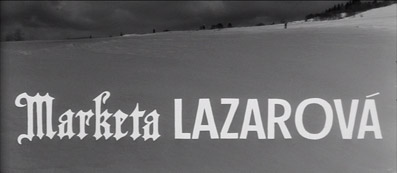
The film, adapted from Vladislav Vančura's avant-garde novel of 1931, tells two singular and tragic love stories and is divided into two parts (Part 1: Straba the Werewolf. Part 11: The Holy Lamb). Each part is subdivided into several titled chapters. The plot revolves around the Kozlík family: its patriarch, Old Kozlík, his wife, Katrina, and their eight sons and nine daughters – particularly Mikolaš (Kozlík's heir apparent), Adama-Jednorucka (one-armed Adam) and their sister, Alexandra.
The action begins with a violent attack by Mikolaš and Adam on the entourage of a Saxon Count, Old Kristián, whose son Young Kristián they capture and drag back to the family stronghold, Rohacek. In the brothers' absence a rival noble, the pitiful Lazar, swoops to loot, only to be caught in the act by the returning Mikolaš, who spares his life as he had earlier spared Kristián's. Back at Rohacek, Old Kozlík and Mikolaš quarrel over Old Kristián's escape and the presence there of his son.
Old Kozlík argues that this will bring retribution to their doors – as it, ultimately, does, for the outraged King subsequently orders his Marshall, Pivo, to hunt down the clan. As Adam prepares to behead Kristián, Old Kozlík orders a stay of execution, on those pragmatic rather than compassionate grounds. A current of mutual attraction passes between Kristián and the sensual Alexandra. A flashback shows Alexandra making love to a man at a pagan shrine (we later learn that the man was her brother, Adam, and that he lost his arm after a snakebite suffered as the siblings made love).
Mikolaš visits Lazar at his fortress, to persuade him to join forces with the Kozlík family against the King. We see Lazar's daughter Marketa for the first time as she observes Mikolaš ride toward the fort. It is clear she knows of Mikolaš, if by local legend alone, and there is a suggestion of erotic charge in her gaze. After Lazar refuses to aid the Kozlíks, Mikolaš is set upon and badly beaten by Lazar's men.
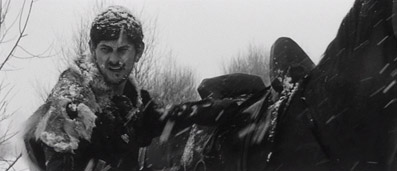
Marketa rushes to his aid and her intervention convinces Lazar to allow Mikolaš's escape. The Kozlíks return, later, to attack Lazar's fortress in revenge. Mikolaš seizes Marketa and the Koliks depart, leaving the fort in flames and Lazar nailed to its gates. At the family's encampment in the woods, Mikolaš rapes Marketa as Adam looks on, while Alexandra unties Kristián and makes love to him.
The film's second half begins with the appearance of Bernard, an itinerant preacher or 'holy fool', whom Lazar and Marketa had earlier met while returning home from the convent for which she was intended. The narrator admonishes Bernard for his sexual relationship with a sheep ("You know she is no woman, as you are no lamb"). Thereafter, Bernard meanders, as a tragic-comic cypher binding the narrative, through the chaotic scenes that follow, as the King's army closes in to confront the Kozlíks in battle, all the way to the film's climax.
Those are mere hints of a coherent but complex and fragmented plot. Vláčil's interest, though, lay not in plot but in psychology, time and place. The appearance of the title in the opening credits – with the word Marketa in Gothic script, the word Lazarová in a contemporary font – immediately announces that the film will combine the ancient and the modern. Vláčil invokes a mediaeval fable in what might nowadays be called "cutting edge form." Hostile to conventional historical dramas, with their formulaic narratives and tendency to sanitise the past, Vláčil sought, paradoxically, to evoke the 13th Century with an authenticity born of obsession, while deploying every formal innovation he could muster.
Vláčil studied the living conditions and traditions of 'primitive' tribes; read history, anthropology and mythology voraciously; and painstakingly schooled his actors in their characters' psychology. The clothing, tools and weapons used replicated those of the Middle Ages to the minutest detail. Locations were scouted for their resemblance to the landscapes and dwellings of those days (the script stipulated the events depicted occurred between 15 February and 1 August 1250).
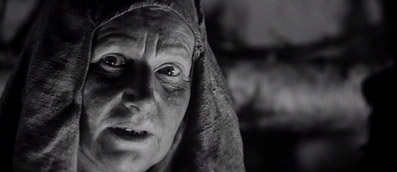
Much influenced by Pieter Bruegal's pre-modern yet proto-modern paintings, Vláčil carefully cast his actors, most of whom were non-actors, for physical attributes in keeping with feudal times. Prior to appearing in the film František Velecký (Mikolaš) was a construction engineer, Vlastimil Harapes (Kristián) was a dancer and Pavla Polaskova (Alexandra) was a designer. Marketa Lazarová was played by Magda Vášáryová, the daughter of school teachers (Vášáryová would later become, successively, the Czechoslovak ambassador to Austria, the Slovakian ambassador to Poland and Slovakia's Secretary of State for Foreign Affairs). Even the movements of the animals involved – four hawks and an eagle, a sheep, a goat, a serpent, countless deer, horses and wolves – were often orchestrated under tight directorial control.
If the film often looks and feels like it might have been made in 1250, it often sounds as if were – while, equally often feeling like it might come from tomorrow. Much of its sense of tradition and immediacy owes much to renowned composer Zdeněk Liška's extraordinary score. Liska drew on traditional music but also invented new instruments for the film, so discordant percussive effects work alongside hauntingly melodic neo-choral fugues to create an unforgettable polyphonic whole that enhances the wider whole.
Vláčil's meticulous methodology, his rigorous approach and his capacity to recreate the conditions and sensibilities of his ancestors might simply have resulted in one of the most astonishing historical films ever made. Vláčil's ambition, however, didn't begin and end with a forensic examination of 13th Century life. He wanted no less than to produce a modern film poem while painting a picture of universal human nature and reflecting on his times. He achieved this additional ambition with some of the most exquisite cinematography seen, with an exceptional script adapted from an extraordinary novel and by showing us life stripped to the bone. He did so, too, by referring to the struggle between polytheistic Paganism and emerging Christianity. His inference is that clear parallels can be drawn between that struggle and that of Soviet Power with the pluralistic, anti-authoritarian tendencies which flowered, albeit briefly, during the Prague Spring. For Vláčil there were obvious similarities between the dogmatic rigidities of Stalinism and Christianity, between the Christianisation process occurring during the 13th Century and the Sovietisation of Eastern Europe.

Vláčil stood outside the Czech New Wave, partly due to his subject matter, but also because he confronted contemporary problems less directly and obviously than did New Wave directors like Ivan Passer and Evald Schorm. Unlike his New Wave contemporaries, he didn't graduate from the Prague Film School (FAMU) but, rather, studied art and aesthetics, and cut his directorial teeth while making films for the military. As an art student, we are told, he drew Eisenstein's Battleship Potemkin (1926) frame by frame. The levels of patience, determination and respect for the image that implies are apparent in Marketa Lazarová. Vláčil's commitment to precise, poetic composition and his capacity to pin a moment down with an exact image shine through in every perfect frame, as does his love and knowledge of cinema.
Just as Bergman acknowledged his debt to Kurosawa's Jidai-geki masterpieces Rashomon (1950) and Seven Samurai (1954), so Vláčil acknowledged his to Bergman's The Seventh Seal (1957) and Virgin Spring (1960). But, while Marketa Lazarová owes much to Kurosawa and Bergman, it probably owes more to two Soviet films released as Vláčil was at work on Marketa Lazarová: Paradzhanov's Shadows of Our Forgotten Ancestors (1965) and Tarkovsky's Andrei Rublev (1966). Certainly those historical epics echo in the film and the ominous bells of Andrei Rublev echo in Zdenek Liska's score. Paradzhanov and Tarkovsky blossomed during Krushchev's Thaw, only to be cruelly marginalised and maligned when the permafrost of the Stalinist status quo bit deep once more, just as Vláčil fell foul of authority during and after the 'normalisation' period following the Prague Spring.
Marketa Lazarová's monochrome magnificence is a joy to behold. From the opening scenes it is obvious we are in the hands of a master. Seldom have black and white images been so masterfully manipulated nor looked so sumptuous. Some of the images created by Vláčil and his hard-worked cinematographer, Bedřich Batka, are unforgettable. It would be easy to fill this review with descriptions of startlingly images. Discourteous though it feels to do so, though, I'd like to single out one image one, beautiful in itself while revealing much about Vláčil's work.
After the decisive battle between the Kozlíks and the King's forces, Marketa and Mikolaš, deeply in love now, take their leave of one another. As they caress tenderly, Mikolaš tells Marketa about a hunting trip with his father. He explains how they had tracked one particular stag to "a bare plain – grass, stones, lichen – more wretched than a cemetery – bones, limbs, a 1000 white sculls. The stag stood there in the middle, defeated, alone. Kozlík whispered, 'Look, the solitude of death'." The hunter and the hunted, Vláčil is saying, share the same fate. Marketa comes to see Mikolaš in that stag, which reappears on screen when she later picks up his cloak and lovingly presses it to her face. Later, when she is approaching the convent, she thinks of Mikolaš and the stag appears again, centre screen, alert, alone. Then something shocking happens. The stag stops moving. So does the film. It becomes a photograph. For a couple of seconds the stag looks at us from the screen, frozen in time.

Vláčil is reminding us of our common destiny here but also paying homage to the similarly sublime moment in Chris Marker's La Jetée (1962), when, rather than stopping, a still image springs to life. It points to Vláčil's knowledge of contemporary cinema and his tendency to experimentation. The stag scenes are typical of Vláčil's decision to eschew the easy temptations of linear narrative. Marketa Lazarová is, it must be said, a difficult as well as wonderful film. The narrative is, as I've said, fragmented, and the plot reveals itself only incrementally. Images move back and forward in time, flashbacks are interwoven with real-time scenes, narrative clues are released, only gradually, through a series of vignettes or tableaux. The chapter titles help but they are often cryptic. The film is a puzzle, the pieces of which only reveal the complete picture when assembled. As critics Emory Menefee and Ernest Callenbach noted in their 1967 Film Quarterly review of the film:
"Nothing in it is charming or picturesque. Hair is matted, filth is routine; none of the living arrangements are familiar. Partly as a result of this, and partly from its complex structure, the film is initially as confusing as it would be to arrive in such an alien culture. We don't at first have the slightest idea what people are up to... Vláčil never makes compromises: he makes us figure out what is happening for ourselves."
The difficulty of the film arises partly from the complexity of its source material. Vláčil and co-writer František Pavlicek, a playwright and theatre director, worked for three years on their adaptation of Vladislav Vančura's book. An experimental mixture of ancient legend and earthy vernacular, the novel's formal and linguistic invention reputedly renders it untranslatable. Though it was hugely popular (unusually so for an avant-garde work), the novel must have been hard to adapt and Vláčil's decision to do so tells us much about his motives and mindset. Vlačil's enemies characterised him as a self-indulgent aesthete but that does him an injustice. His decision to adapt Vančura, whose more conventional wartime work Pictures from the History of the Czech Nation also informed the film, was motivated by political and philosophical as well as aesthetic considerations. I'd go so far as to suggest that, in the context of the day, it constituted a significant political act.
Vančura, like Vlačil, was an outsider, a freethinking autodidact. Like Vláčil too he fought fearlessly and tirelessly to bring his vision to fruition. A key figure in the Czech Modernism of the inter-war years – a movement fascinated by cinema and language – he was active in the avant-garde Devetsil underground. Vančura was a member of the Communist Party until expelled in 1929 and an active member of the resistance to Nazi Occupation. He was murdered by the Gestapo, during the brutal reprisals following the assassination of Reinhard Heindrich, and occupies a place in the Czech tradition of martyrdom not far short of that held by Jan Hus and Jan Palach. As I have said above, Vančura was that rarest of creatures: an experimental and popular novelist. Czech literature sought to assert a national identity that had been constrained, successively, by Austro-Hungarian, Nazi and Soviet expansionism. Consequently, certain writers came to occupy a special place in the consciousness of Czechs – who regard Vančura as the equal of Karel Capek, Juroslav Hašek, Bohumil Hrabal, Franz Kafka and Milan Kundera. Vančura was, in the Czech phrase, "writing for the drawer" under the Nazi occupation, as surely as others would have to under Soviet occupation. Here, then, was a figure acceptable to the censorious nomenklatura, as an anti-Nazi hero, who also spoke directly to the Czech people as a symbol of cultural and political resistance. Vláčil knew full well what he was doing when he chose to adapt Vančura. He was no fool.
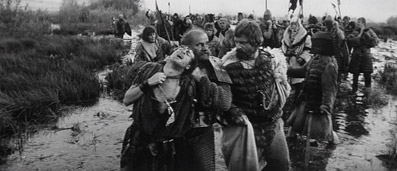
While much of the film's complexity originated in Vančura's novel, it is equally rooted in modernist theories of 'defamiliarisation', theories that chimed with Vláčil's delight in clashing registers and ideas. Peter Hames, discussing Vláčil's opacity in one his excellent essays on the film, suggests that Vláčil was working within Viktor Shklovky's tradition of 'making strange' and 'making difficult'. Vláčil studied aesthetics so must have been aware of the Russian Formalist's work, and of Modernism generally. Modernism's tendency toward formal fragmentation reflected its recognition of social and temporal fragmentation – of the gulf separating freedom and control, the individual and the universal, the minute hand and the eternal. Much the same could be said of Marketa Lazarová.
If Joyce's Finnegan's Wake represented the exclamation mark of Modernism, there is a case to be made for Marketa Lazarova as Film Modernism's defining question mark.. The opening titles of the film state that "the oldest things lie in the present," mirroring the ideas contained in the opening lines of T.S. Eliot's The Four Quartets: "Time present and time past/Are both perhaps present in time future/And time future contained in time past... What might have been and what has been/Point to one end, which is always present." Vláčil would surely have shared Eliot's view that "no generation is interested in art in quite the same way as any other." He would certainly have endorsed Eliot's insistence on the need to review the past and set it in new order every century or so and approved of Ezra Pound's famous injunction to "make it new."
Of course what makes us modern is the past and 'the new' is often older than we realise. It is worth noting, in closing, that Pound coined 'his' famous phrase 'make it new' after discovering it in an 18th Century Frenchman's History of China. Pound tells us, in his Cantos, that the Emperor Tching – who reigned in the 18th Century B.C, over 3000 years before the translation Pound drew on, "prayed on the mountain and wrote MAKE IT NEW on his bath tub." So, it turns out that Modernism's great battle cry was a translation from French, of a translation from Mongolian Chinese, itself a translation from 12th Century neo-Confucian Chinese, of a text older than the bible itself. The shock of the new, then, is often recognised only in retrospect. It is to be hoped that František Vláčil continues to receive the retrospective recognition he so thoroughly deserves.
An impressive 2.35:1 anamorphic transfer of František Vláčil's widescreen, masterpiece, enhanced for widescreen televisions. Contrast is strong, and there is a visual gloom to much of the imagery that results in detail being lost to the solid black tones at times, but this appears to be largely intentional, as in the more evenly lit shots the tonal range is impressive and the detail is always good. The digital transfer is sharp enough to savour without ever dulling the shimmering subtlety of its source, thus allowing the grainy richness of its celluloid ancestor to breathe on.
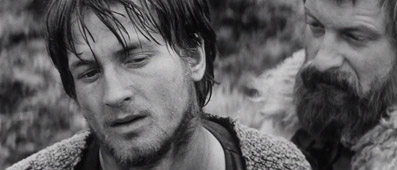
The restored mono soundtrack may have some expected restrictions in range on the dialogue, but in respect of the music and sound effects displays an outstanding clarity and depth for a film of this vintage, and there is no trace of damage or background hiss.
Whether you are inclined to read about films before or after seeing them, you are in for a treat here. For the DVD contains a 16-page keepsake containing images from the film and an exellent essay on Marketa Lazarová by academic, critic, film historian and programmer Peter Hames. There are not many alive who know more about either František Vláčil or Czech Cinema than him. Hames is intelligent, informed, informative and endlessly interesting. This essay looks at Vláčil's wider work and offers proud owners of the DVD further food for thought and fresh insights into the film.
This is the first DVD release of an artful, beautiful film too long hidden from general view. DVD might have been invented for films as complex but captivating as Marketa Lazarová: the more often it's viewed the deeper its depths and truths, the richer its resonances and textures appear. František Pavlišek, who co-wrote the screenplay said: "Fratisek Vláčil became a film director so that he might make Marketa Lazarová." Second Run deserve our eternal gratitude for retrieving, restoring and releasing this extraordinary film as surely as Vláčil deserves our gratitude for making it. Magisterial. Majestic. Highly recommended.
|